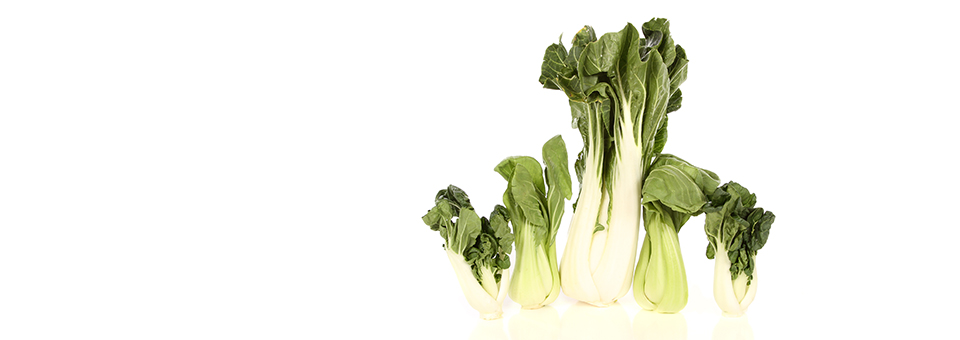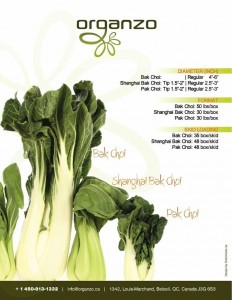Bok Choy
Introduction
This vegetable is a leafy turnip and a “headless cabbage”. Its stems are juicy, crunchy and have a very mild flavour. The leaves are slightly peppery with a touch of bitterness (the baby varieties are more mild).
We distinguish between two varieties of bok choy:
The white bok choy is characterised by its white stems and the white veins on its dark green leaves. Organzo’s preference is the “soup spoon” variety of bok choy which has white and fleshy stems. Pak choy, which is smaller (slightly wrinkly, dark green leaves with short, flat, white stems), looks like our celery but with no strings. Baby white bok choy, the dwarf version (10cm), is stockier (pleated dark green leaves with a short, white and juicy stem).
Bok choy is characterised by its olive green stems, and as with the “Shanghai bok choy” (15 cm), it is harvested as a “miniature” (the leaves and the stems are amid green colour). Its leaves are smooth and round, shaped like a spoon, and are tightly gathered around the heart. This vegetable is currently the most commonly used in Chinese cooking (salad and stirfries) due to its succulent taste and crunchy texture.
Like all “green” Asian vegetables, bok choy has a high nutritional value. Thus, whether it is eaten raw, cooked or marinated, bok choy takes care of your health with its nutrients, protects the digestive tract and stimulates the circulation.
The green leaves of this vegetable are highly valued among athletes who consume no dairy products and with older people because they encourage bone strength (calcium that our bodies can digest easily), and notably it is an excellent source of iron that prevents anaemia.
Organzo: a strategic and authentic partnership between truck farmers and our agronomic services department, from seed to harvest.
We constantly suggest new varieties to improve product qualityand options for seeds that are less prone to ravagers, diseases and physiological disorders.
We walk through the producers’ fields every week looking at and inspecting the slightest defaults in plants, in order to delay any outbreak of ravagers and/or diseases by applying good agricultural practices, and when needed, by rationally using registered pesticides.
Selection and preservation
Look for stems and leaves that are intact, fresh (crunchy) and a vibrant green colour (with no marks).
It keeps well for a week in a perforated plastic bag, otherwise it loses its flavour and vitamins. Wash it just before you intend to use it.
It can be frozen, but as with all vegetables, you must blanch it for two minutes beforehand.
Cooking instructions
The whole plant is edible. In terms of taste, with bok choy we get two vegetables in one, the juicy stems provide an interesting texture while the dark green leaves add a different texture and flavour to our palate.
Due to its high water content, bok choy quickly becomes limp and soft if it is overcooked.
Eat it in salads, sandwiches, smoothies, spring rolls, wraps, dips, soups, fondues, steamed, stuffed in hamburgers, meatballs or dumplings, in marinades, on the BBQ… in your risotto, curry dishes and also in your cheese sauce.
Serve about 250g of bok choy per person for cooked dishes and 150g for a salad. Expect it to reduce by two thirds in size when cooked.


